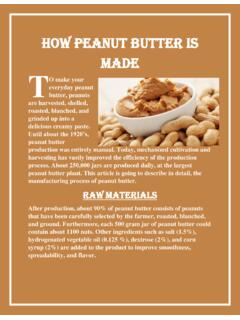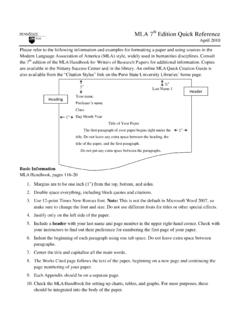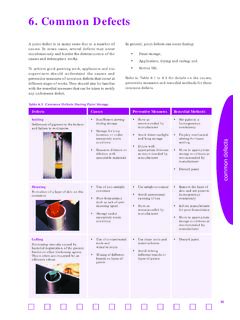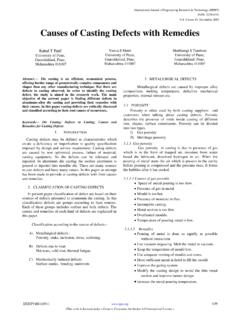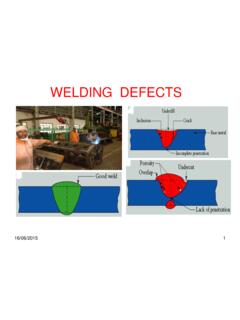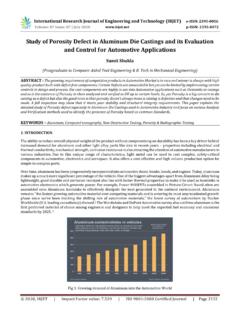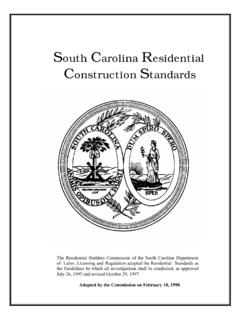Transcription of Sand Casting Design Rules - Sites at Penn State - WordPress
1 Pennsylvania State University 06-Feb-17 SAND Casting Design Rules Santosh Reddy Sama, Guha P Manogharan Sand Casting is the most popular Casting process employed in industry because of its great geometric freedom capability and for its cost effectiveness. In this article, we provide Design Rules for optimal sand Casting performance. 2/6/2017 1 SAND Casting Design Rules Santosh Reddy Sama, Guha P Manogharan It must be emphasized that this article was highly inspired by a brochure Casting Design and Performance by ASM International. The Design of a successful Casting requires an integrated approach that considers both functional and process requirements simultaneously. This article discusses the basic Design considerations of the part and the entire Casting process. Basic part Design : 1. Avoid using sharp corners and angles as they act as stress raisers and may cause cracking and tearing during solidification.
2 Therefore, section changes in castings should be blended smoothly into each other. Design modifications to avoid defects in castings (Sharp corners are avoided to reduce stress concentrations) 2. Extensive horizontal flat surfaces should be avoided as they may warp during cooling because of temperature gradients. They also develop poor surface finish. 3. Do not interpose thin sections between thick sections. 4. Avoid isolated thick section. The effects of Design on distortion of castings. (a) Top view of Casting ; numbers indicate moduli of the two sections. (b) Distortion caused by solidification stresses 2/6/2017 2 Basic mold Design : Part orientation in the Casting Orientation of the part should be such that the large portion of the Casting is relatively low and the height of the Casting is minimized. Parting line Design 1. Parting line should be along a flat plane rather than be contoured.
3 Irregular parting lines should be prevented until and unless it is unavoidable. Designing for a straight parting line to reduce pattern and Casting costs. (a) Irregular parting line is a costly Design . (b) Straight parting line is less expensive. 2. For less dense material (like Al alloys), parting line should be placed as low as possible 3. For denser metals (like steels), mid-height location is recommended. 4. Parting line greatly influences the total cost of the Casting process. It has effects on the total required number of cores, gating system and weight of the final Casting . 5. Critical dimensions should not cross parting lines in molds. Pattern Design 1. A small draft (~ to 2o) should be provided to enable removal of the pattern without damaging the mold. 2/6/2017 3 Thin disc whose edges have been drafted 2. Pattern should also take into account the following allowances and should be fabricated accordingly: a.
4 Patternmaker s shrinkage because of solid-solid contraction (~1% to 2%). b. Machining allowance (~2mm to 5mm for small castings and to more than 25mm for large castings). Core Design 1. An important rule in economical Casting Design is to eliminate as many Design features requiring cores as possible. Cores that are only absolutely necessary for producing the desired shape should be used if Design is to be directed toward lower cost castings. 2. Core consolidation is one such method where we reduce the total number of cores by integrating several cores and designing them as a single one. 2/6/2017 4 Restrictions to pattern removal and some potential solutions Redesign of castings to eliminate cores. (a) Casting redesigned to eliminate outside cores. (b) implication of a base plate Design to eliminate a core. (c) Redesign of a bracket to eliminate a core and to decrease stress problems.
5 Solidification characteristics: 1. Almost all molten alloys, with some important exceptions, undergo shrinkage during solidification. 2. The basic objective of good Casting Design is to concentrate this liquid-solid contraction to the last portion(s) of the Casting to solidify. 2/6/2017 5 3. We use Chvorinov s rule as the basic technique to study solidification process and the rule states that the time of solidification is directly proportional to the square of the volume-to-area ratio of the Casting (or Casting section). This section modulus approach is an approximate analysis scheme to provide valuable insights into the solidification times and, therefore, the propensity for defect formation during solidification. 4. According to this rule, solidification progresses from the parts that have least section modulus to the locations where section modulus is high.
6 Objective is to Design such that Casting sections should freeze progressively, so that the contraction results in a sound part. 5. This is generally done by adding reservoirs of molten metal called risers/feeders that feed liquid metals to the last portion of the Casting to solidify. Risers are designed to have the highest Casting modulus. 6. The portion where the Casting modulus is very high in the Casting will freeze slowly and will have properties that defer from adjacent locations. These locations are called hotspots and our aim is to eliminate all the hot-spots to the maximum extent possible. 7. Elimination of hotspots can be possibly achieved by: a. Adding cores to the thickest section b. Feeding molten metal through risers c. Redesigning the junction 8. Accelerating the solidification of a section of the Casting that will need to solidify at a faster rate to eliminate hotspots can be attained by inserting 2/6/2017 6 chills inside the mold cavity before pouring.
7 Chills are of two types. Internal chills are directly fused into the Casting and External chills helps to remove heat from the Casting faster than the surrounding material. Types of Chills: Internal Chills and External Chills Riser Design : 1. Risers help to feed liquid metal into the last portion of the Casting . Proper placement of the risers on castings changes the way in which both the Casting and riser(s) solidify such that the riser is the last to solidify. 2. When designed correctly, a Casting that s free of shrinkage will be produced because all the shrinkage for the entire mass of both Casting and riser will be concentrated in the riser. 3. Riser location: a. Solidification should proceed directionally from those parts of the Casting farthest from the riser, through the intermediate portions of the Casting , and finally into the riser itself, where the final solidification will occur.
8 B. Risers should be placed to achieve the maximum pressure differential and, when possible, should be open to the mold surface. Blind or enclosed risers must be adequately vented. c. Top riser is typically more efficient than the side riser d. For a side riser, it is recommended to gate through the Casting for maximum effectiveness. e. Flow of material is very important to the manufacturing process. Do not feed a heavy section through a lighter one. 2/6/2017 7 f. Avoid large masses in locations distant to risers 4. Shape of riser: a. A cylindrical shape has a good volume-to-area ratio and is easily moldable and hence is recommended. b. Side riser should be provided with a hemispherical bottom to prevent premature freezing of the riser/ Casting junction. 5. Size of riser: a. Top risers: Riser height should be at least equal to the riser diameter.
9 B. Side risers: Riser height as times the riser diameter is often used. 6. Number and size of risers should be minimized to increase mold yield and to reduce production costs. Various methods can be used to establish this criterion: a. Chilling the Casting : Reducing the solidification time b. Insulating the riser: Extending its solidification time. 7. Insulating the riser greatly reduce cooling in the risers from the steep temperature gradient between the liquid metal of the Casting , and the room temperature air. Gating system Design : 1. A gating system refers to all passageways through which the molten metal passes to enter the mold cavity. The basic components of a simple gating system are pouring basin, sprue, runner, gates. Schematic of a traditional gating system layout 2/6/2017 8 2. General gating system Design Rules : a. A gating system should fill the mold cavity completely before freezing.
10 B. Minimizing turbulence plays an important role in the quality of the Casting . A turbulence metal flow tends to form dross in the mold. Avoid sudden or right angle changes in flow direction. c. A proper thermal gradient should be maintained so that the Casting is cooled without any shrinkage cavities or distortions. d. System Design should be economical to maximize the yield and should be easy to implement and remove after Casting solidification. 3. Pouring basin Design : a. Pouring basin is the first part of the gating system to handle the molten metal and maintain pressure head over sprue. A good Design of pouring basin eliminates the slag entering the down sprue. a) Conical pouring basin and b) Offset step basin b. Conical basin: Conical pouring cups are the most popular cups almost everywhere in the foundry industry. Advantages: 1. Easy to make 2. Inexpensive Drawbacks: 1.
